I have been achieving goals by improving productivity through my 20+ years of experience working for multiple corporations in multiple roles including sales, software engineering, and project/product manager.
I love working.
I love thinking about improving productivity.
I love learning new things.
Sometimes we are so excited about work that we forget to pay attention to other aspects of our lives. This FullFocus planner is very useful for people like me. It teaches us the importance of taking a step back, taking a deep breath, and looking at life from multiple perspectives, helping us achieve our goals in each situation.
The Full Focus Planner is developed by experienced business coach – Mychael Hyatte. It emphasizes not only work productivity but also the promotion of a balanced lifestyle.

There are so many “Planners” out there as well as so many reviews that just list every single feature of those. I’m sure your question is “How different is this one from others?”.
In this article, I cover the Full Focus Planner’s Unique features.
Disclaimer: All opinions are my own. As an Amazon Associate, I earn from qualifying purchases.
1. What is a Full Focus Planner?
- An undated 90-day paper planner, produced by Michael Hyatt & Co.
- Helps you build your annual goals and break them down into shorter time spans – quarterly, monthly, weekly, and daily goals. Each time pan is provided with dedicated reviews.
- Teaches you how to process your thoughts systematically to build effective goals that are assisted by
2. Distinctive feature 1: Effective Goal Settings
2.1 SMARTER Goal Settings
You create up to 10 Annual Goals by using the SMARTER framework.
Then you assign 2-3 for each quarter.
The SMARTER goals enhance your ability to accomplish your goals

What is the SMARTER framework?
SMARTER is an acronym that stands for:
S – Specific: Goals should be clearly defined and detailed, not vague.
M – Measurable: Goals should have concrete criteria to measure progress and know when you’ve achieved them.
A – Achievable: Goals should be realistic and attainable within the resources and time available.
R – Relevant: Goals should align with your overall objectives and priorities.
T – Time-bound: Goals should have a clearly defined timeframe including a target date.
E – Evaluate: Build in time to regularly evaluate progress and learnings against your goals.
R – Re-adjust: Be flexible and willing to re-adjust goals based on learnings and changing circumstances.
The SMARTER framework helps create well-defined, focused, and actionable goals with clear measures and deadlines. Setting SMARTER goals leads to more effective execution and follow-through.
SMARTER goal setting is key to goal achievement


I want to remove the $2000 credit card debt within the next 12 months. what would the SMARTER goal settings look like?
In that case, it will look like this
Specific: Reduce my credit card debt.
Measurable: Pay off $2000 of debt this year.
Achievable: Allocate $200 per month to pay down debt. Relevant: Becoming debt-free will reduce stress and eliminate interest payments.
Time-bound: Start making $200 monthly payments in March.
Evaluate: Review debt amount monthly.
Re-adjust: If needed, increase payment amount or find ways to trim expenses.


Sounds great.
I like the “Re-adjust” part. That makes me prepare a planB in case it is getting hard to achieve. It is very proactive.
For more details on SMARTER goal settings, I put here 2 references below:
2.2 Categorizing goals by Domain fosters mental organization and thought refinement.
As part of Goal setting, you will categorize each goal into below 10 domains:
- Spiritual
- Intellectual
- Emotional
- Physical
- Marital
- Parental
- Social
- Vocational
- Avocational
- Financial

Some of the domains are new to me.
My goal has been mostly about
– Work (Vocational, Intellectual)
– Hobby(Avocational, Intellectual)
– Health (Physical)
– Family (Marital and Parental)
– Money (Financial)
Never paid attention to
– Spiritual
– Social
what are those? any examples?
Sure. Let’s look at each Domain and examples.

| 1 | Spiritual | Specific: Connect spiritually through nature walks/hiking Measurable: Take 2 nature walks per week for a minimum 30 minutes Achievable: Research suitable walking trails to visit near my home Relevant: Immersing in nature often leads to spiritual insights for me Time-bound: Aim to schedule 2 walks per week starting in April Evaluate: Each month, reflect on my spiritual state and any insights gained from nature. Make notes in a journal. Re-Adjust: If the desired spiritual connection is not happening, try longer walks or visit new locations. Walk with others for spiritual discussions. |
| 2 | Intellectual | Specific: Improve my knowledge of machine learning and AI. Measurable: Read 2 books and take an online course by the end of the year. Achievable: Set aside 30 mins to read 3x per week. Enroll in the course in June. Relevant: This will help me stay up-to-date in my field as a software engineer. Time-bound: Start reading in March, take a course in June-August timeframe. Evaluate: Take notes on my learning and reflect on new concepts mastered. Re-Adjust: If the course is too advanced, find alternate introductory content. |
| 3 | Emotional | Specific: Improve my emotional regulation skills Measurable: Practice mindfulness meditation for at least 15 minutes per day. Track progress in a journal. Achievable: Start with 5 minutes per day and gradually increase to 15 minutes over 2 months. Relevant: Being able to manage my emotions better will reduce stress and improve my overall well-being. Time–Bound: Practice daily meditation starting March 1st, aim to reach 15 minutes per day by May 1st. Evaluate: Review my progress and emotional state monthly. Note insights and improvements. Re-Adjust: If I struggle to meditate, explore alternate grounding practices like yoga or breathwork. |
| 4 | Physical | Specific: Improve my cardiovascular fitness. Measurable: Exercise 4x per week for 30 minutes with a target heart rate in the aerobic zone. Achievable: Start with 15-minute jogs and build up the duration weekly. Relevant: Better fitness will reduce my stress and risk of disease. Time-bound: Start workout schedule in April, reach 4x/week by June. Evaluate: Log workouts and monitor heart rate monthly. Re-adjust: If too challenging, modify intensity and build more gradually. |
| 5 | Marital | Specific: Strengthen my marriage through better communication. Measurable: Have a date night 2x per month and a 10-minute check-in daily. Achievable: Schedule date nights and check-in times in the calendar. Relevant: Improving my connection with my spouse will enhance intimacy. Time-bound: Initiate check-ins and date nights starting in March. Evaluate: Assess our communication and satisfaction monthly. Re-adjust: Try a relationship counseling session if needed. |
| 6 | Parental | Specific: Be more engaged with my kids and their interests. Measurable: Spend 30 mins of dedicated 1-on-1 time with each child per week. Achievable: Plan activities suited to each child’s interests. Relevant: Strengthening my bond with my kids will benefit our family. Time-bound: Start 1-on-1 time in February, aim for consistency. Evaluate: Get feedback from my kids on our relationship. Re-adjust: Find ways to improve conversation and activities with them. |
| 7 | Social | Specific: Expand and diversify my social network. Measurable: Meet 2 new people per month through clubs, events, etc. Achievable: Research local groups and clubs to join based on my interests. Relevant: Meeting new people will expose me to new perspectives and opportunities. Time-bound: Join a club in March, start attending regularly. Evaluate: Assess if I am connecting meaningfully with new people. Re-adjust: Try different types of social settings if needed. |
| 8 | Vocational | Specific: Gain skills to advance to a management role. Measurable: Complete leadership training program by year-end. Achievable: Talk to my manager about the training options available. Relevant: Developing leadership skills will prepare me for the next step in my career. Time-bound: Enroll in the program by June, and complete by December. Evaluate: Apply learnings on the job and get manager feedback. Re-adjust: If the program is not relevant, look into alternate programs or on-the-job training. |
| 9 | Avocational | Specific: Learn to play acoustic guitar. Measurable: Practice guitar 30 minutes per day and learn 5 new songs this year. Achievable: Break playing into 10-minute sessions. Find beginner-level songs to learn. Relevant: Playing guitar will be a fun creative outlet and stress reliever. Time-bound: Obtain a guitar in February. Aim to learn 1 new song per month. Evaluate: Record my practices to review progress. Identify areas for improvement. Re-Adjust: If struggling, take a few guitar lessons to improve technique. |
| 10 | Financial | Specific: Reduce my credit card debt. Measurable: Pay off $2000 of debt this year. Achievable: Allocate $200 per month to pay down debt. Relevant: Becoming debt-free will reduce stress and eliminate interest payments. Time-bound: Start making $200 monthly payments in March. Evaluate: Review debt amount monthly. Re-adjust: If needed, increase payment amount or find ways to trim expenses. |
These 10 domains are great resources to ask yourself to shape your life goal.


Thank you. Now I need time to think.
Of course. This process takes hours.
Categorizing goals by life domain and self-reflecting clarifies core values to chart a purposeful life direction

I always use letter size papers and pen and do some brain dumps first. Then formulating each goal.
- What is my life role? As a son/daughter, as a parent, as a spouse, as a social worker, as a corporation worker, as a resident of this community, as a member of this karate club, as a citizen of this state, etc…
- What do I like/dislike? What am I good/poor at? And why?
- What is my relationship with money? how much do I need? And why?
- What is my passion? And why?
- Who do I want to become? And why?
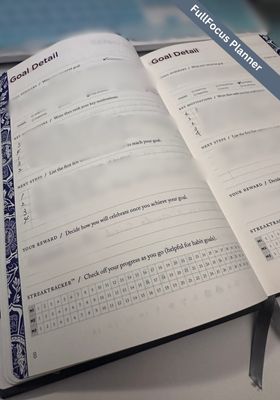
3. Distinctive feature2: Productivity Enhancement
3.1 “Ideal Week” to batch up similar tasks

What is Ideal Week?
Ideal Week” concept emphasizes grouping similar tasks together within specific days of your week to boost your productivity and focus. By batching similar tasks, you minimize context switching and mental friction, allowing you to deep dive and achieve a flow state more effectively.

Let’s break it down.
1. Defining Your Ideal Week:
The planner encourages you to map out your ideal week by categorizing your tasks into three groups:
- Front Tasks: Visible tasks for others, like meetings, presentations, or client calls.
- Back Tasks: Tasks invisible to others, like research, preparation, email follow-ups, or administrative work.
- Off Tasks: Personal tasks unrelated to work or professional development, like errands, hobbies, or exercise.
2. Benefits of Batching Tasks:
- Reduced Context Switching: Jumping between different types of tasks constantly creates mental strain and slows you down. Batching similar tasks minimizes this and allows you to focus on one context for an extended period.
- Improved Flow State: Immersing yourself in a specific type of task for a longer duration helps you achieve a flow state, where you work more efficiently and productively.
- Reduced Decision Fatigue: Choosing what to do next constantly drains your mental energy. Batching eliminates this decision fatigue by pre-planning your tasks for each day.
- Better Time Management: Blocking out time for specific types of tasks helps you visualize your week and manage your time more effectively.
3. Example:
Imagine you have research, writing, and client calls throughout the week. Instead of randomly doing each task, you could:
- Block Monday and Wednesday mornings for focused research, allowing you to delve deep into the topic without distractions.
- Dedicate Tuesday afternoon to writing, uninterrupted by other tasks.
- Schedule all client calls for Thursday or Friday mornings, creating a dedicated block for external communication.
The Ideal Week concept and batching similar tasks are powerful tools for boosting your productivity and achieving your goals by minimizing distractions and maximizing focus. The Full Focus Planner provides a framework and guidance to implement this approach effectively.

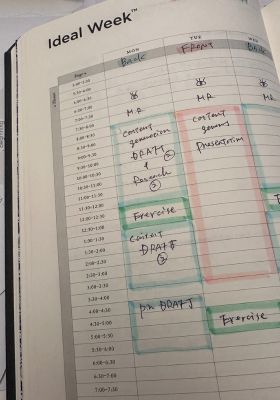
3.2 Rituals / Routines

I have a morning routine and an evening routine.
But I want to review and understand better the purpose of doing routines once again.
Sure.
The Full Focus Planner emphasizes the importance of creating personalized rituals to structure your workday and improve productivity.

The planner prompts you to define 4 key rituals:
| # | Ritual Type | Purpose | Examples |
|---|---|---|---|
| 1 | Morning Ritual: | Sets the tone for your day, promoting focus and positive energy | meditation, exercise, journaling, healthy breakfast |
| 2 | Workday Startup Ritual: | Prepares you for productive work | reviewing goals, prioritizing tasks, clearing your workspace |
| 3 | Workday Shutdown Ritual: | Transitions you away from work and helps you unwind | reviewing accomplishments, reflecting on learnings, planning for tomorrow |
| 4 | Evening Ritual: | Prepares you for a restful sleep and a productive next day | winding down with calming activities, disconnecting from screens, spending time with loved ones |
Research suggests that rituals offer several benefits for productivity:
- Reduce Anxiety: Repetitive actions associated with rituals provide a sense of control and predictability, easing anxiety and stress, which can hamper focus and performance.
- Trigger Habits: Rituals act as cues to activate desired behaviors, making it easier to transition into productive work modes or wind down from work stress.
- Boost Confidence: Successfully completing a ritual can create a sense of accomplishment and self-efficacy, leading to increased confidence and motivation throughout the day.
- Promote Mindfulness: Rituals involving mindfulness practices like meditation or reflection can improve focus and attention, critical for productivity.
As per “Don’t stop believing: Rituals improve performance by decreasing anxiety” (2016), how rituals performed before stressful performances (singing in this case) reduced anxiety and improved performance compared to simply waiting. It argues that rituals decrease anxiety, leading to better performance.
Alison Wood Brooks, Juliana Schroeder, Jane L. Risen, Francesca Gino, Adam D. Galinsky, Michael I. Norton, Maurice E. Schweitzer, Don’t stop believing: Rituals improve performance by decreasing anxiety, Organizational Behavior and Human Decision Processes, Volume 137, 2016, Pages 71-85, ISSN 0749-5978, https://doi.org/10.1016/j.obhdp.2016.07.004.
By incorporating personalized rituals into your day, you can tap into the power of these science-backed practices to enhance your focus, productivity, and overall well-being

4. Professional quality tutorial guide
Full Focus Planner – Tutorial Guide
It describes WHY you need to do as well as HOW to proceed for each template page. And it is a completely free guide that you can learn a lot.
By checking respective videos, you’ll gain the knowledge and tools to leverage the FullFocus system in the Planner, expanding your productivity and focus, and the opportunity to achieve your goal

5. Generic Features
Like other productivity/business planners, FullFocus Planner provides Goal setting, Monthly calendar, Weekly review/Plan, and Daily plans.
The full Focus Planner page lists details
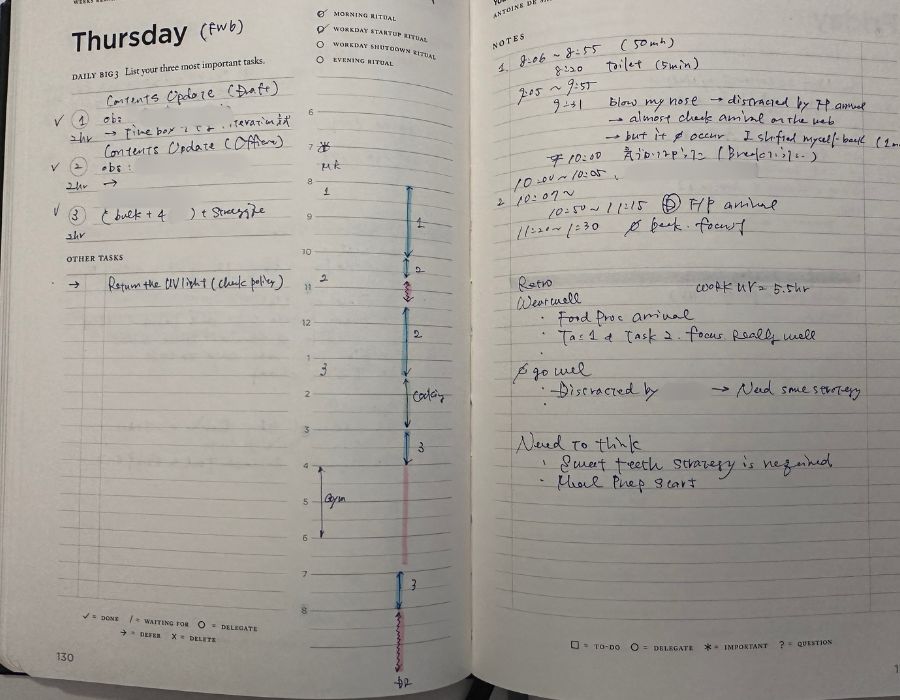
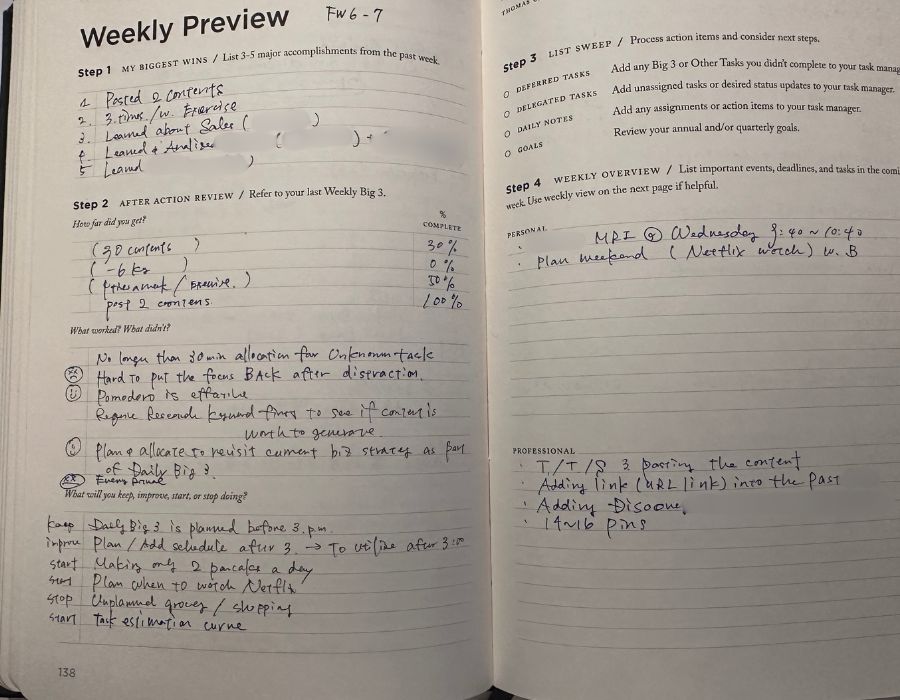
Also, FullFocus Planner has some key features such as
- Habit Tracking
- Quarterly Reviews

What is so unique about Habit Tracking in FullFocus Planner?
In the FullFocus System, “Habit Tracking” is considered as 1 of the Goal Settings.

When you set up Goal Details, you categorize the goal as either Achievement or Habit.
If your goal is building new habits, then you can record your activity as part of STREAKTRACKER within the Goal Details page as well as the Weekly Preview page.
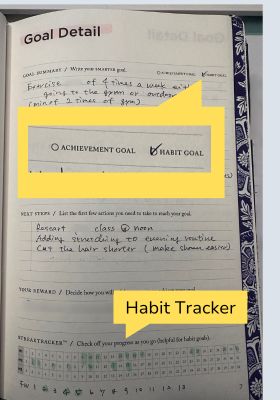
The FullFocus planner is 90-day planner, so at the end of the 90 days, you can review your outcome. That is the Quarterly Review. FullFocus provides the template page for the review

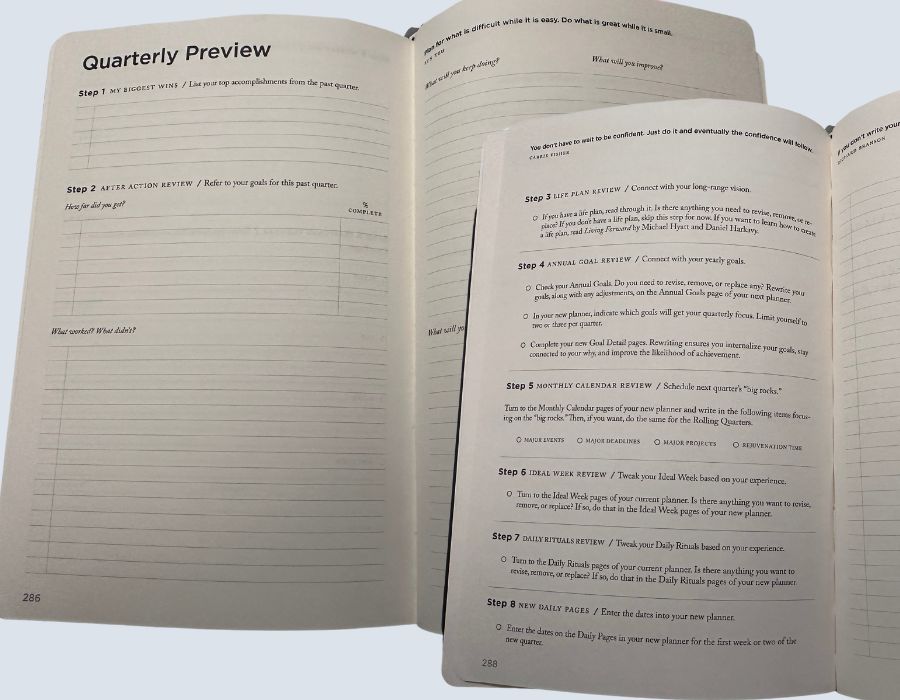
6. Best for Who?
This planner is for people who
- Professionals seeking a structured approach to achieving ambitious goals
- Individuals overwhelmed by balancing multiple life domains
7. NOT for Who?
- Those needing detailed time management tools or hourly productivity tracking
- Digital users looking for digital templates
- Those need daily appointment and scheduling management system
8. Conclusion
If you’re tired of traditional planners that leave you feeling overwhelmed or disorganized, and you’re seeking a structured approach to achieve ambitious goals, the Full Focus Planner is definitely worth exploring.
Its unique system for setting SMARTER goals, categorizing them for clarity, and implementing strategic daily rituals can empower you to take control of your productivity and well-being.
With its free tutorial resources and a community of engaged users, the Full Focus Planner offers more than just a planner; it provides a supportive framework for achieving your vision.
